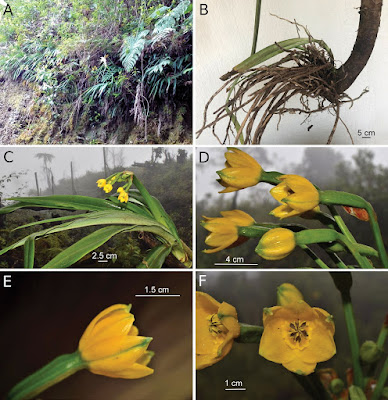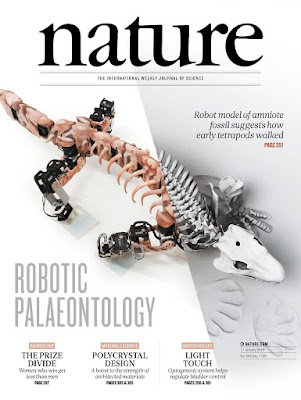[Most Recent Entries] [Calendar View]
Thursday, January 17th, 2019
| Time | Event | ||||
| 1:37p | [Botany • 2019] Pamianthe ecollis (Amaryllidaceae) • A Remarkable New Species of Pamianthe from the Department of Cauca, Colombia
Abstract A new saxicolous species of Amaryllidaceae tentatively assigned to the tribe Clinantheae, Pamianthe ecollis Silverst., Meerow & Sánchez-Taborda, is described from the western slope of the Cordillera Occidental in the department of Cauca, Colombia. The new species differs from the two hitherto known species of Pamianthe in its yellow flowers and in its nearly obsolete perianth tube. The near loss of the perianth tube may be correlated with a change in pollinator. The new species lacks a bulb; it produces a large number of winged seeds that are wind-dispersed. A key to the species of Pamianthe is provided. This is the first record of the genus Pamianthe for Colombia. The phylogenetic position of the genus Pamianthe is discussed. Keywords: Amaryllidaceae, biodiversity, Cauca, Clinantheae, Colombia, Pamianthe, Andes Pamianthe ecollis Silverst., Meerow & Sánchez-Taborda, sp. nov. Diagnosis: This species differs from both Pamianthe parviflora Meerow and P. peruviana Stapf in having a yellow perianth and staminal cup (versus white) and in nearly lacking a perianth tube. Additionally, it differs from P. parviflora in having shorter pedicels, a longer ovary, and more numerous ovules, and from P. peruviana in having much longer pedicels, more flowers per umbel, much shorter tepals, a shorter staminal cup that is not exserted from the perianth, and a smaller fruit. .... Etymology: The specific epithet is from Latin, e (without), collum (neck), adjectival collis, referring to the almost absent perianth tube of this species. Alan W. Meerow, Philip A. Silverstone-Sopkin, Alejandro Zuluaga-Tróchez and Jhon A. Sánchez-Taborda. 2019. A Remarkable New Species of Pamianthe (Amaryllidaceae) from the Department of Cauca, Colombia. PhytoKeys. 115: 73-82. DOI: 10.3897/phytokeys.115.30755 Resumen: Se describe una nueva especie de Amaryllidaceae tentativamente perteneciente a la tribu Clinantheae, Pamianthe ecollis Silverst., Meerow & Sánchez-Taborda, procedente de la vertiente occidental de la cordillera Occidental en el departamento del Cauca, Colombia. La nueva especie difiere de las dos especies conocidas de Pamianthe por su perianto amarillo que tiene un tubo casi ausente. La reducción del tubo del perianto probablemente tiene correlación con un cambio en el polinizador. La nueva especie carece de un bulbo, y produce numerosas semillas aladas que se dispersan por el viento. Se provee una clave a las especies de Pamianthe. Este es el primer registro del género Pamianthe para Colombia. Se discute la posición filogenética del género Pamianthe. | ||||
| 2:31p | [Paleontology • 2019] Reverse-engineering the Locomotion of A Stem Amniote, Orobates pabsti
Abstract Reconstructing the locomotion of extinct vertebrates offers insights into their palaeobiology and helps to conceptualize major transitions in vertebrate evolution. However, estimating the locomotor behaviour of a fossil species remains a challenge because of the limited information preserved and the lack of a direct correspondence between form and function. The evolution of advanced locomotion on land—that is, locomotion that is more erect, balanced and mechanically power-saving than is assumed of anamniote early tetrapods—has previously been linked to the terrestrialization and diversification of amniote lineages. To our knowledge, no reconstructions of the locomotor characteristics of stem amniotes based on multiple quantitative methods have previously been attempted: previous methods have relied on anatomical features alone, ambiguous locomotor information preserved in ichnofossils or unspecific modelling of locomotor dynamics. Here we quantitatively examine plausible gaits of the stem amniote Orobates pabsti, a species that is known from a complete body fossil preserved in association with trackways8. We reconstruct likely gaits that match the footprints, and investigate whether Orobates exhibited locomotor characteristics that have previously been linked to the diversification of crown amniotes. Our integrative methodology uses constraints derived from biomechanically relevant metrics, which also apply to extant tetrapods. The framework uses in vivo assessment of locomotor mechanics in four extant species to guide an anatomically informed kinematic simulation of Orobates, as well as dynamic simulations and robotics to filter the parameter space for plausible gaits. The approach was validated using two extant species that have different morphologies, gaits and footprints. Our metrics indicate that Orobates exhibited more advanced locomotion than has previously been assumed for earlier tetrapods7,9, which suggests that advanced terrestrial locomotion preceded the diversification of crown amniotes. We provide an accompanying website for the exploration of the filters that constrain our simulations, which will allow revision of our approach using new data, assumptions or methods.
John A. Nyakatura, Kamilo Melo, Tomislav Horvat, Kostas Karakasiliotis, Vivian R. Allen, Amir Andikfar, Emanuel Andrada, Patrick Arnold, Jonas Lauströer, John R. Hutchinson, Martin S. Fischer and Auke J. Ijspeert. 2019. Reverse-engineering the Locomotion of A Stem Amniote. Nature. 565; 351–355. DOI: 10.1038/s41586-018-0851-2 Scientists Used a Robot to Study How Prehistoric Lizards Walked po.st/q36h28 via @SmithsonianMag Ancient animal walked tall, surprising scientists on.natgeo.com/2FCymWh via @NatGeoScience |
| << Previous Day |
2019/01/17 [Calendar] |
Next Day >> |






